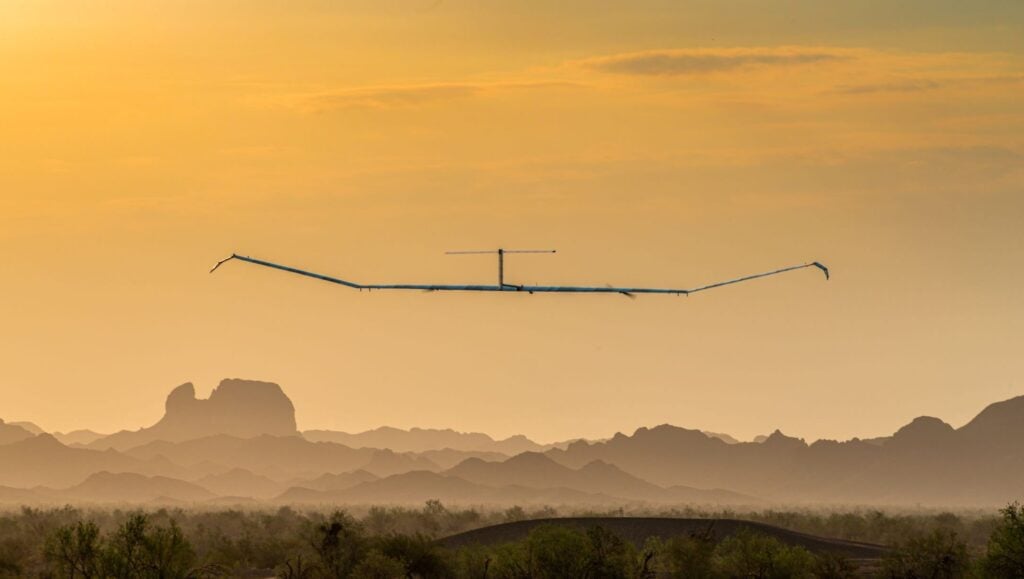
The Zephyr high-altitude drone (Airbus)
GEOINT 2021: The Army’s Project Convergence 2021 wargame launches today at Yuma Proving Grounds in Arizona and White Sands Missile Range in New Mexico, where the service will test out new technologies, capabilities and operational concepts for future All Domain Operations.
“The Army’s taking 110 technologies to the field for six weeks to figure out: do they do what we think they can do? Will they interoperate?” Ed Mornston, head of intelligence and security (G2) at Army Futures Command, told the annual GEOINT Symposium last week.
Over the past year, the Army has been running a serious of “communications exercises,” or “COMEX,” that have revealed some of the issues the service has with simply getting its own weapon systems to talk to each other, Mornston said last Thursday. The most recent iteration had just finished at Ft. Leonard Wood in Eagleton, Mo., he noted. The Army also has been testing out each of the technologies at its Joint Systems Integration Laboratory at Aberdeen Proving Grounds in Maryland.
“Unfortunately, some of the Army’s signature modernization efforts, as spectacular as they are, don’t work with the other signature modernization efforts,” he said. (The service has a portfolio of 35 modernization priorities, that range from from 1,725-mile hypersonic missiles to augmented-reality targeting goggles.)
The kickoff of Project Convergence 2021 happens to coincide with the start of annual Association of the United States Army (AUSA) trade show in Washington, DC, where Army officials will be bringing industry up to speed on the flagship effort. The massive wargame is aimed at developing the next-generation capabilities the Army will need to implement DoD’s Joint All Domain Command and Control (JADC2) strategy, and the evolving Joint Warfighting Concept for taking on Russia and China in globe-spanning future conflicts.
The wargame will involve the 82nd Airborne Division, along with the Army’s Multi-Domain Task Force as the key operational units, Mornston said, running through seven different “use cases,” i.e. tactical scenarios.
It also will involve representatives of the Air Force, Navy and Marine Corps, he explained, making the wargame “truly a joint effort.” Of the 110 new technologies being reviewed, some 35 of them come from the other services, he explained.
Next year’s Project Convergence will go further, he added, inviting allies.
While Mornston did not reveal specifics about the technologies themselves — noting that the service, and DoD writ large must remember that US competitors, especially China, are masters of open-source research — the Army has previewed some capabilities over the past year in smaller wargames, such as the EDGE21 aviation exercise in the spring.
During EDGE21, the service field-tested a number of new systems ranging from jamming pods to infantry goggles to software that allowed battlefield operators to take over the controls of a drone and task it to gather targeting data — all made possible by a prototype Modular Open Systems Architecture, the invisible, digital backbone of the Army’s future air fleet.
A Focus On Army’s Own ISR
Key to Project Convergence, and to the Army’s overarching plan for high-speed future warfare, is the ability for taskable, over-the-horizon sensors that provide the intelligence, surveillance and reconnaissance (ISR) to enable targeting of the service’s developing arsenal of very long-range weapons, or in Army-speak, long-range precision fires.
For example, Army leaders, which for decades have complained that they does not receive the battlefield-ready ISR it needs in a timely manner from either the Air Force or the Intelligence Community (IC), are now seeking to develop their own ISR satellite payloads that they can task for themselves.
RELATED: Army, NRO Pioneer Direct Sat Imagery Downlink In ‘Scarlet Dragon’
And in that arena, but short of space, Project Convergence will include testing of the Zephyr very-high altitude spy drone, according to industry officials.
Zephyr, developed by Airbus, is a solar-electric High Altitude Platform System (HAPS) with a wingspan of 25m and weighing less than 75kg, the the company’s website says. It flies at around 70,000 feet (21 kilometers) in altitude, which is about double the height of conventional air traffic and above storm clouds.
Variants of the drone have been undergoing Army testing at Yuma for about a decade. Zephyr in 2010 broke the world record for the longest autonomous drone flight; and in 2019 it stayed aloft day and night for almost 26 days.
Airbus completed another testing campaign at Yuma with the latest version of the drone, Zephyr S, last month, according to an Oct. 11 press release. During that test it successfully streamed Earth observation imagery from the new Optical Advanced Earth Observation system for Zephyr (OPAZ) system. Zephyr also has now received approval from the Federal Aviation Administration to fly in US national airspace, the release noted.






















